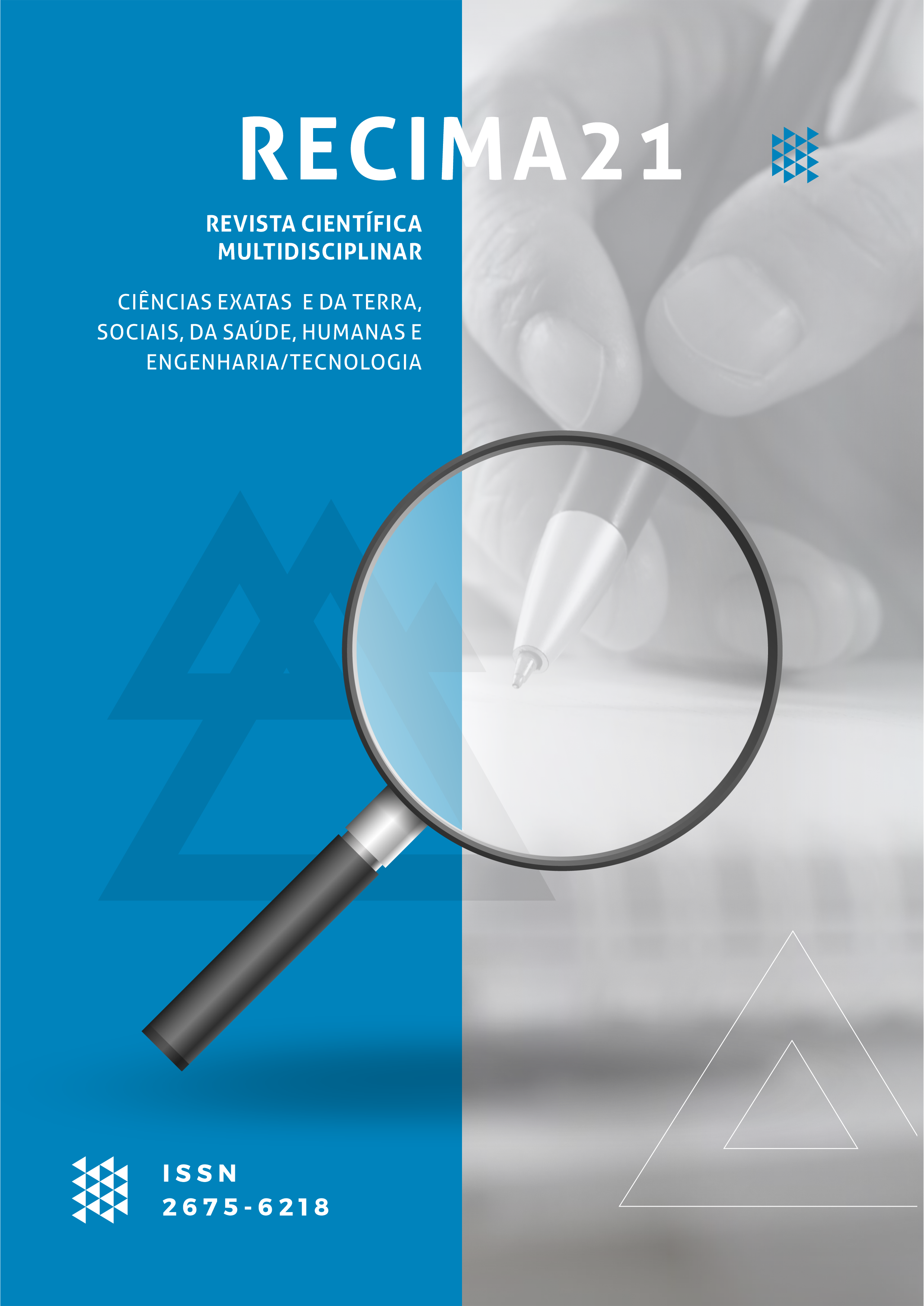FACTORS RELATED TO CANDIDIASIS VULVOVAGINAL IN WOMEN IN THEIR LIFE CYCLE: AN INTEGRATIVE REVIEW
DOI:
https://doi.org/10.47820/recima21.v3i10.2021Keywords:
Candidiasis, Risk fator, Vulvovaginitis, InfectionAbstract
Vulvovaginal candidiasis (VVC) is caused by the abnormal growth of yeast-like fungi in the mucosa of the female genital tract as a result of a series of endocrine and immunological changes and the indiscriminate and prolonged use of antibiotics. In this perspective, the present work aimed to carry out a search in the databases in order to find scientific evidence that points to factors related to vulvovaginal candidiasis in women in their life cycle. The search was performed in the databases Latin American and Caribbean Literature in Health Sciences (lilacs); Scientific Electronic Library Online (SciELO); Medical Literature Analysis and Retrieval System Online (Medline/Pubmed) and in the Nursing Database (BDENF), using the respective Decs/MeSh, as well as the Boolean connectors AND and OR. From the primary search, 403 scientific productions were found and, after analyzing the exclusion criteria referring to the year of publication and thematic, 12 articles eligible for this integrative review were obtained. The selected studies involved women of childbearing age and pregnant women. Most of the publications were carried out in 2019 and 2020. It is noted that hormonal imbalance was the most prevalent associated risk factor. Among the microbiota agents identified, Candida albanis was the most prevalent microorganism in all studies. Vaginal discharge was the most frequent symptom in all studies. In addition, nine studies reported irritation of the vulva and vagina, vulvar erythema and vaginal itching in the fertile period, among other symptoms.
Downloads
References
ANG, X. Y. et al. Lactobacilli reduce recurrences of vaginal candidiasis in pregnant women: a randomized, double-blind, placebo-controlled study. Journal of Applied Microbiology, v. 132, n. 4, 2021. Disponível em: https://pubmed.ncbi.nlm.nih.gov/34022103/ Acesso em: 24 set. 2022.
AHANGARI, F. et al. Comparing the effectiveness of Salvia officinalis, clotrimazole and their combination on vulvovaginal candidiasis: A randomized, controlled clinical trial. J Obstet Gynaecol Res, v. 45, n. 4, p. 897-907, 2019. Disponível em: https://pubmed.ncbi.nlm.nih.gov/30663184/ Acesso em: 24 set. 2022.
ARAÚJO, I. M. et al. Caracterização sistemática da resposta imune à infecção por Candida. Braz. J. Hea. Rev. v. 3, n. 2, p. 3788-803, set. 2020. Disponível em: https://brazilianjournals.com/ojs/index.php/BJHR/article/view/9325 Acesso em: 24 set. 2022.
BANAEIAN, S. et al. Comparison of vaginal ointment of honey and clotrimazole for treatment of vulvovaginal candidiasis: A random clinical trial. J Mycol Med, v. 27, n. 4, p. 494-500, 2017. Disponível em: https://pubmed.ncbi.nlm.nih.gov/28760590/ Acesso em: 24 set. 2022.
BATISTA, J. E. et al. Fatores associados à presença de Candida spp. em amostras de fluido vaginal de mulheres residentes em comunidades quilombolas. Medicina, v. 53, n. 2, 2020. Disponível em: https://www.revistas.usp.br/rmrp/article/view/166251#:~:text=Conclus%C3%A3o%3A%20Os%20achados%20sugerem%20uma,candid%C3%ADase%20vulvovaginal%20neste%20grupo%20populacional. Acesso em: 24 set. 2022.
CARVALHO, N. S. et al. Protocolo Brasileiro para Infecções Sexualmente Transmissíveis 2020: infecções que causam corrimento vaginal. Epidemiol. Serv. Saúde. v. 30, sp. 15, mar. 2021.Disponível em: http://scielo.iec.gov.br/scielo.php?script=sci_abstract&pid=S1679-49742021000500007&lng=pt&nrm=iso Acesso em: 24 set. 2022.
DUARTE, S. M. S.; FARIA F. V.; MARTINS, M. O. Métodos diagnósticos para a caracterização de candidíase e papilomavírus humano. Journal of Development, v.5, n.10, p. 18083-18091, 2019. Disponível em: https://brazilianjournals.com/ojs/index.php/BRJD/article/view/3647#:~:text=O%20diagn%C3%B3stico%20da%20instala%C3%A7%C3%A3o%20e,regi%C3%A3o%20vaginal%20e%20do%20%C3%BAtero. Acesso em: 24 set. 2022.
FREITAS, L. F. Q.; MAIA, L. R. S.; DEUS, M. R. A. R. Prevalência de microrganismos em secreção vaginal de gestantes de alto risco de uma maternidade em Caruaru, pernambuco, Brasil. Jornal Brasileiro de Patologia e Medicina Lboratoral, n. 56, p. 1-6, 2020. Disponível em: https://www.scielo.br/j/jbpml/a/kkY6g3H9FQrcZYbthNDn7cC/abstract/?lang=pt Acesso em: 24 set. 2022.
FURTADO, H. L. A. et al. Fatores predisponentes na prevalência da candidíase vulvovaginal. Rev. Investig, Bioméd. São Paulo, v. 10, n. 2, p. 190-97, mai. 2018. Disponível em: http://www.ceuma.br/portalderevistas/index.php/RIB/article/view/225#:~:text=As%20esp%C3%A9cies%20mais%20predominantes%20na,%2C%20h%C3%A1bitos%20culturais%2C%20entre%20outros. Acesso em: 24 set. 2022.
GOW, N. A. R.; YADAV, B. Microbe Profile: Candida albicans: a shape-changing, opportunistic pathogenic fungus of humans. Microbiology, v. 163, n. 8, p. 1145-147, set. 2017. Disponível em: https://www.microbiologyresearch.org/content/journal/micro/10.1099/mic.0.000499?crawler=true#:~:text=References-,Microbe%20Profile%3A%20Candida%20albicans%3A%20a%20shape%2Dchanging%2C,opportunistic%20pathogenic%20fungus%20of%20humans&text=Candida%20albicans%20is%20normally%20a,of%20the%20skin%20or%20nails. Acesso em: 24 set. 2022.
JALDANI, S.; FATAHINIA, M.; MARAGHI, E. et al. Comparison of the effectiveness of Satureja khuzestanica and clotrimazole vaginal creams for the treatment of vulvovaginal candidiasis. J Med Life, v. 14, n. 1, p. 111–117, 2021. Disponível em: https://www.ncbi.nlm.nih.gov/pmc/articles/PMC7982263/#:~:text=The%20results%20of%20this%20study,statistically%20significant%20difference%20between%20them. Acesso em: 24 set. 2022.
JÚNIOR, J. E. E. et al. A Fungal Immunotherapeutic Vaccine (NDV-3A) for Treatment of Recurrent Vulvovaginal Candidiasis—A Phase 2 Randomized, Double-Blind, Placebo-Controlled Trial. Clin Infect Dis, v. 66, n. 12, p. 1928–1936, 2018. Disponível em: https://pubmed.ncbi.nlm.nih.gov/29697768/ Acesso em: 24 set. 2022.
KHALILZADEH, S. et al. Efficacy of a vaginal tablet as a Persian medicine product on vulvovaginal candidiasis: a double-blind, randomised, placebo-controlled trial. Pharm Biol, v. 58, n. 1, p. 574-580, 2020. Disponível em: https://pubmed.ncbi.nlm.nih.gov/32615837/ Acesso em: 24 set. 2022.
LARA, J. Cepas de Candida albicans en pacientes con diabetes mellitus. Rev Cien Mund Inv. RECIMUNDO [Internet], v. 3, n. 1, p. 1306-1339, 2019. Disponível em: https://recimundo.com/index.php/es/article/view/418 Acesso em: 24 set. 2022.
LÍRIO, J. Antifungal (oral and vaginal) therapy for recurrent vulvovaginal candidiasis: a systematic review and meta-analysis. Rev. Assoc. Med. Bras. v. 68, n. 2, fev. 2022. Disponível em: https://www.scielo.br/j/ramb/a/nfQn5KXcbHcHYc9RghjChgH/ Acesso em: 24 set. 2022.
MAKANJUOLA, O.; BONGOMIN, F.; FAYEMIWO, S. A. An update on the doles of non-albicans Candida species in vulvovaginitis. J Fungi, v. 4, n. 121, 2018. Disponível em: https://pubmed.ncbi.nlm.nih.gov/30384449/ Acesso em: 24 set. 2022.
MUNIZ, S. D. B. Prevalência de candidíase vulvovaginal em mulher de 18 a 30 anos. Journal of biology, v.15, n. 1, p. 9-17, 2019.
MUSHI, M. F.; MMOLE, A.; MSHANA, S. E. Candida vaginitis among symptomatic pregnant women attending antenatal clinics in Mwanza, Tanzania. BMC research notes, v. 2, n. 1, p. 1-5, 2019. Disponível em: https://bmcresnotes.biomedcentral.com/articles/10.1186/s13104-019-4793-z Acesso em: 24 set. 2022.
PAPPAS, P. G. et al. Invasive candidiasis. Nature Reviews Disease Primers. v. 4, n. 18026. p. 1-20, 2018. Disponível em: https://pubmed.ncbi.nlm.nih.gov/29749387/ Acesso em: 24 set. 2022.
QUITO, J. M. O.; CÁRDENAS, P. K. E. Identificación y susceptibilidad de Candida spp. en el área ginecológica. Vive (El Alto), v. 4, n. 11, 2021. Disponível em: http://www.scielo.org.bo/scielo.php?pid=S2664-32432021000200223&script=sci_arttext Acesso em: 24 set. 2022.
RAIMUNDO, J. S. et al. Plantas com atividade antifúngica no tratamento da candidíase: uma revisão bibliográfica. Revista Uningá Review. São Paulo, v. 29, n. 2, p. 75-80, fev. 2017. Disponível em: https://revista.uninga.br/uningareviews/article/view/1953 Acesso em: 24 set. 2022.
REIS, M. G. Candidíase vaginal: características, causas e tratamento. Revista Multidisciplinar em Saúde. Rio de Janeiro, v. 2, n. 4, p. 73-87, maio. 2021. Disponível em: https://editoraime.com.br/revistas/index.php/rems/article/view/2217#:~:text=Tal%20patologia%20afeta%20frequentemente%20o,pelo%20menos%20uma%20vez%20em Acesso em: 24 set. 2022.
RIBEIRO, S. M. et al. Antimicrobial and antibiofilm activities of Casearia sylvestris extracts from distinct Brazilian biomes against Streptococcus mutans and Candida albicans. BMC complementary and alternative medicine. v. 19, n. 1, p. 308, 2019. Disponível em: https://pubmed.ncbi.nlm.nih.gov/31718633/ Acesso em: 24 set. 2022.
ROCHA, W. R. V. et al. Gênero Candida - Fatores de virulência, Epidemiologia, Candidíase e Mecanismos de resistência. Research, Society and Development. v. 10, n. 4, p. 391-423, maio. 2021. Disponível em: https://redib.org/Record/oai_articulo3174815-g%C3%AAnero-candida--fatores-de-virul%C3%AAncia-epidemiologia-candid%C3%ADase-e-mecanismos-de-resist%C3%AAncia Acesso em: 24 set. 2022.
RUSSO, R. et al. Randomised clinical trial in women with Recurrent Vulvovaginal Candidiasis: Efficacy of probiotics and lactoferrin as maintenance treatment. Mycoses, v. 62, n. 4, p. 328-335, 2019. Disponível em: https://pubmed.ncbi.nlm.nih.gov/30565745/ Acesso em: 24 set. 2022.
SILVA, H. S. F. et al. Principais aspectos referentes à candidíase vulvovaginal. Revista científica integrada. v. 4, n. 4, p. 23-33, out. 2020. Disponível em: https://www.unaerp.br/revista-cientifica-integrada/edicoes-anteriores/volume-4-edicao-4/3686-rci-candidiasevulvovaginal-072020/file#:~:text=Clinicamente%2C%20a%20CVV%20%C3%A9%20caracterizada,em%20vulvovaginites%20de%20outras%20etiologias. Acesso em: 24 set. 2022.
TAKIMURA, M.; OLIVEIRA, G. R.; GAVIOLI, L. C. Recurrent vaginal discharge: a myth or a fact? / Corrimento vaginal recorrente: mito ou fato? DST j. bras. doenças sex. transm, v. 30, n. 3, p. 90-95, 2018. Disponível em: https://pesquisa.bvsalud.org/portal/resource/pt/biblio-1121509 Acesso em: 24 set. 2022.
YANO, J. et al. Current patient perspectives of vulvovaginal candidiasis: incidence, symptoms, management and posttreatment outcomes. BMC Women's Health. v.19, n. 48, p. 1-21, set. 2019. Disponível em: https://pubmed.ncbi.nlm.nih.gov/30925872/ Acesso em: 24 set. 2022.
ZAKERIA, S. et al. The effect of Achillea Millefolium L. on vulvovaginal candidiasis compared with clotrimazole: A randomized controlled trial. Complement Ther Med, v. 52, p. 102483, 2020. Disponível em: https://www.sciencedirect.com/science/article/abs/pii/S0965229919320394 Acesso em: 24 set. 2022.
Downloads
Published
How to Cite
Issue
Section
Categories
License
Copyright (c) 2022 RECIMA21 - Revista Científica Multidisciplinar - ISSN 2675-6218

This work is licensed under a Creative Commons Attribution 4.0 International License.
Os direitos autorais dos artigos/resenhas/TCCs publicados pertecem à revista RECIMA21, e seguem o padrão Creative Commons (CC BY 4.0), permitindo a cópia ou reprodução, desde que cite a fonte e respeite os direitos dos autores e contenham menção aos mesmos nos créditos. Toda e qualquer obra publicada na revista, seu conteúdo é de responsabilidade dos autores, cabendo a RECIMA21 apenas ser o veículo de divulgação, seguindo os padrões nacionais e internacionais de publicação.

 Clique para ver detalhes
Clique para ver detalhes 











